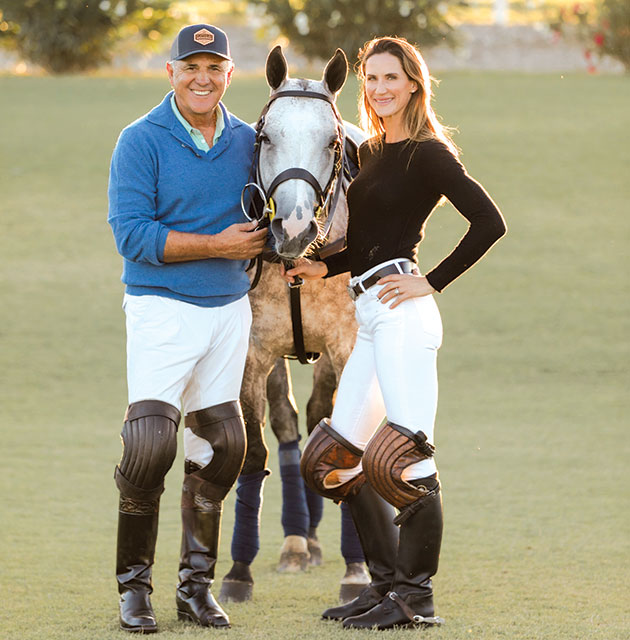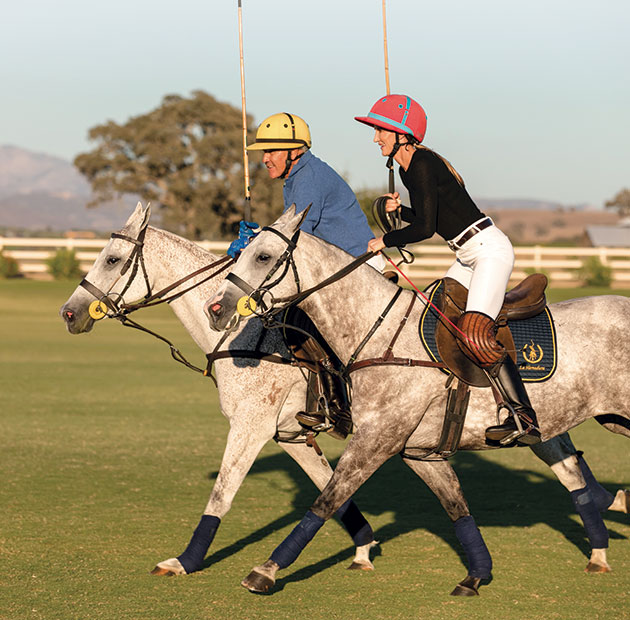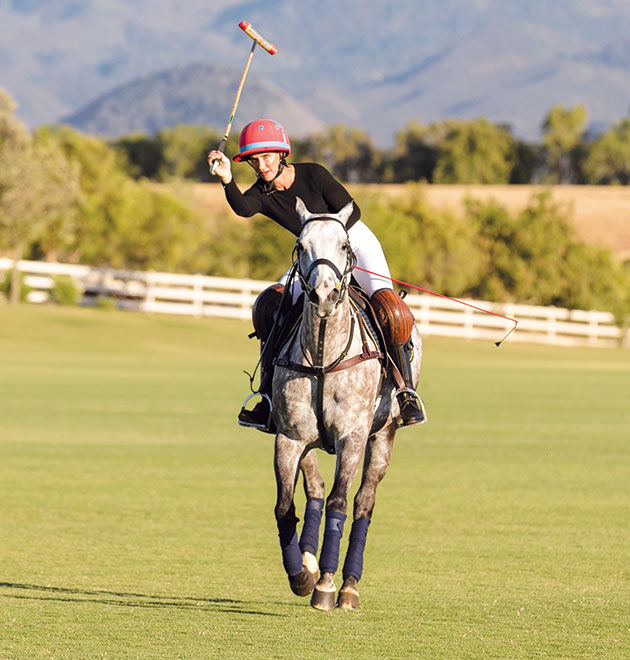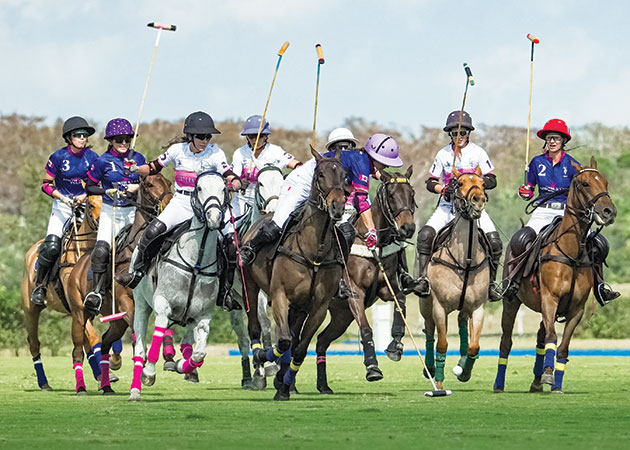Meghan Gracida has Carved Her Own Path as Competitor, Breeder and Passionate Leader in Women’s Polo; This 5-Goal Handicap Player is Also the Wife of Famed International Polo Star Memo Gracida
The sport of polo holds undeniable allure. To the untrained eye, the “sport of kings” is enveloped in glitz and intrigue. Dating back over two millennia, the glitz is its association with royalty and nobility in a Great Gatsby world of extravagance. One must be wealthy to field a four-rider team, needing at least six ponies per player per match. Thundering ponies (all animals are referred to as polo ponies for their agility and speed) racing down an imposing field (300 by 160 yards) at speeds up to 35 mph, piloted by players who expertly wield a mallet to club the softball-size high-impact ball through goal posts, 8 yards wide. At halftime, glamorous and impeccably dressed spectators exuberantly stomp divots on the 10-acre playing field while sipping Veuve Clicquot under the sun. It’s an international sport with top polo clubs stretching from Montecito, California, to Wellington, Florida, to the Hamptons on the eastern tip of Long Island in New York state, and abroad from the United Kingdom to Dubai to Argentina; the latter known as the polo capital of the world in part because it has the most players with a 10-goal status, the highest ranking in the game. Simply, it’s a scene made for the big screen.
Most people have only a surface-level perception of the game. Beneath the shiny surface a deep culture surrounds the world of polo, marked by talented riders, deeply connected families and a world where grooms, players, “patrons” (team benefactors) and their mounts serve each other. Families like the Gracidas, who were known as the first family of Mexican polo before the siblings moved north, have helped evolve modern-day polo over the generations. Guillermo “Memo” Gracida Jr., born in 1956 and considered the best polo player of his generation, and his younger brother, Carlos, tragically killed in a 2014 polo accident, standing as two of the sport’s most famous players, breeders and advocates. Favorites of the late Queen Elizabeth II of the United Kingdom, the brothers have left an indelible mark on the sport, not just as two of the winningest competitors of all time but as true horsemen. Their deep passion for polo and the horses at the backbone of the sport stems from their father, Guillermo Sr., and his three brothers, who won the U.S. Open Polo Championship playing for Mexico in 1946. The tradition carries on — Memo, Carlos and their cousins all became distinguished professional polo players — and includes talented players by way of spouses and children, including Memo’s wife, Meghan.
She’s at home on the sidelines of a polo match; the former college volleyball outside hitter from Eastern University in Pennsylvania, who played professional beach volleyball, is tall (5-foot-10) and classically elegant, well-spoken and impeccably stylish. At the same time, however, she’s wildly unexpected. Meghan is gritty, determined, athletic and competitive. She has transformed before the eyes of the polo community from a novice in the sport to a strong, kind and eloquent voice of leadership among women polo players, all while riding and competing like a seasoned pro.
Polo Fast Facts
- History: Dates back over two millennia and is associated with royalty and nobility
- Teams: Consists of four riders, needing at least six ponies per player per match
- Equine Athletes: All are referred to as polo ponies for their agility and speed, reaching up to 35 mph
- Field: 300 by 160 yards
- Objective: Players wield a mallet to club a softball-size, high-impact ball through goal posts that are 8-yards wide

A New World
Born and raised on California’s Central Coast, it was during a trip to Wellington, Florida (the mecca of East Coast polo), where the polo outsider met the ultimate insider: Memo, a handsome and thoughtful man that is, in so many ways, a contrast to what most imagine of a polo player of his caliber. “In my eyes, I quickly saw him as the wonderful human he is,” Meghan recalls. “He’s just a superb, genuine and very humble person.” The two, having a near-instant connection, fell in love, and Meghan was thrust into the entirely new world of professional international polo. “I had next-to-no background riding, and I certainly didn’t know anything about polo,” she says of their early days together. Moreover, she was completely unaware that Memo was a living legend in the polo world. “I got to know him first as a person before I realized the impact he has had on the sport,” she adds.
Memo, who has been riding horses since he was 2 years old, admits that it’s the horses that truly captivate him, even more so than the game of polo, to which he’s dedicated his life’s work. “Memo is a passionate horseman, and while I’ve loved horses for my entire life, I was truthfully terrified of them,” Meghan admits. She and Memo married on Dec. 10, 2014, just a few years after meeting and traveling the world for his polo and horse breeding enterprises. At that point, she resolved to confront her phobia. “I wanted to ride and learn, but I had this overwhelming fear,” she confirms. Then, early in her marriage and barely into her 30s, she was diagnosed with cancer. “It was a shock to say the least,” she says. As she recovered in Florida, she thought back to her time as an athlete. She dug deep into that competitive mindset to overcome the fears holding her back from the joy and adventure that riding would bring. “I was enamored by this sport. The culture is incredible. It’s so familial,” she says. “To the Gracida family polo isn’t a sport, it’s a lifestyle.” Decision made, Meghan dove headfirst into horses, riding and even polo when she got her sea legs under her. “I remember finally coming to the conclusion that, if I’m 30 years old and getting cancer, I am going to get over this fear,” she adds. “I thought, ‘I want this. I want to live this life. I want to enjoy horses with my husband, and I’m not going to let this fear stop me.’ ”

Purchased for her by Memo Gracida, Patito Feo was Meghan's first polo pony. It was on him that Memo taught her how to ride.
Purchased for her by Memo Gracida, Patito Feo was Meghan's first polo pony. It was on him that Memo taught her how to ride.
As Meghan grew stronger in 2016, Memo found the ideal equine partner to carry his wife while on a polo-related trip to South America. “Memo very graciously bought me my first polo pony in Argentina,” she fondly recalls. “His name is Patito Feo, which means the ‘ugly duckling’ in Spanish. He saw this beautiful gray gelding being played in some chukkers (the six, 7-1/2-minute periods that make up a polo match). The horse was on the younger side, but Memo, being so astute, knew what I needed.” Coincidentally, Patito Feo was a foal bred by Memo from two of his best horses and born on Memo’s farm. With crooked conformation as a weanling, Memo sold the horse in 2012. Four years later, the animal that had blossomed into a beautiful gray gelding was on his way back into the Gracida fold with his original owner and, soon, into Meghan’s heart. “In the winter of 2017, Patito Feo arrived in Florida, and he changed my life,” she says. “He has such a personality. He’s extremely smart, and he’s frisky. He’d buck and kick out, which was scary for a novice rider, but somehow, I knew that he would never try to hurt me. It was on Patito Feo that Memo taught me how to ride, to be one with the horse and to be in control. I formed an incredible bond with this horse, and I credit Patito Feo for getting me over my fear.”
Under the gentle tutelage of the master horseman, the former ugly duckling took Meghan from a zero-goal handicap to a confident and quickly rising three-goal player.
“I’ve been extremely fortunate to be on horses that are of the utmost quality. ... Horses are 95% of it. A good horse makes a great player even greater.”
— Meghan Gracida, Women’s Polo 5-Goaler
Finding Her Passion
As her confidence in the saddle grew, so did her proficiency with a mallet. Known for his unique abilities as a coach, Memo guided Meghan as she mastered the fundamentals of polo and steadily improved to the point where she was competing on the pitch. She quickly became enveloped in the sport that is deeply engrained in the Gracida family’s life. “Learning to be a better horseman just never stops. It’s a lifelong process, but as a player, it becomes an instinct,” she says. “I felt that instinct kick in when I went from a 3-goal to a 4-goal player. That’s when things started changing for me in terms of my confidence and abilities.” Meghan is quick to also credit the string of exceptional polo ponies assembled by Memo for her prowess on the polo field: “I’ve been extremely fortunate to be on horses that are of the utmost quality. Memo has done a fantastic job of providing me the appropriate horse flesh to really help me grow within the sport. Horses are 95% of it. A good horse makes a great player even greater. And a poorly performing horse makes even the greatest players less effective.” The horses, she says of the 40-plus polo ponies required per team in each match, are “without question, the most important part of the game. Most polo players treat their horses better than they treat themselves. There’s a true value in the equestrian athlete that is unlike any other sort of partnership. They’re even cloning the great polo ponies now, which has taken off greatly in South America — in Argentina in particular.”
Polo is evolving, and with it comes an entirely new approach to the science of breeding, training, conditioning and nourishing the power at the center of the sport.

“I’d argue that Platinum Performance®, in addition to the high-quality forage they receive, has given our horses an advantage in terms of their health and performance. ... We believe Platinum helps set our horses apart,” says Meghan Gracida.
“I’d argue that Platinum Performance®, in addition to the high-quality forage they receive, has given our horses an advantage in terms of their health and performance. ... We believe Platinum helps set our horses apart,” says Meghan Gracida.
A Competitive Edge
Memo is a long-respected breeder of top-quality polo ponies and knows what a good horse is and how to establish bloodlines for athleticism, longevity and temperament. Beyond his eye for talent and breeding experience, Memo enjoys a reputation for taking impeccable care of his animals. The couple and their team place a heavy consideration on the intricate detail of every horses’ management. While the herd is stalled for a certain amount of time daily, the Gracidas prioritize turnout as much as possible, believing that horses do best in a natural grazing environment. “At some points in the year we have over 300 horses here in Santa Ynez at La Herradura,” says Meghan of their large working and breeding facility located about 15 minutes east of Solvang on the Central Coast. “That’s a huge number of horses for anyone to take care of but especially when so many of them are high-performing athletes and lesson horses.” Certain months see portions of La Herradura’s herd transported to compete in other polo hotspots. “We shipped over 30 horses to Wellington, Florida, in December ahead of the season’s start there this January,” explains Meghan. “We have five grooms taking care of those horses, with each groom being responsible for about six horses. Our horses are fed the best forage available, and I’d argue that Platinum Performance®, in addition to the high-quality forage they receive, has given our horses an advantage in terms of their health and performance. We have ponies here on Platinum Gastric Support — one of my favorites — which is a product I wish everyone knew about to support gastric health. We believe Platinum helps set our horses apart.”
A Spectator’s Guide to Polo
Field of Play
A full-size outdoor, or grass, playing field is 300 by 160 yards, approximately 10 acres or the area of nine football fields.
Objective
Drive the ball between the opponent’s goal posts and score the most goals to win the game.
Chukkers
Polo is divided into periods called chukkers, which last 7-1/2 minutes each. Excluding overtime, a polo game, outdoor or indoor, consists of between four and six chukkers, depending on tournament stipulations. A match generally lasts one to two hours because of penalties, timeouts and overtime.
Direction of Play
The initial direction of each team is chosen based on a coin toss before the game. Teams move in the direction of their goal until the first goal is scored, after which teams switch goals. Direction is changed after each score.
Player Positions and Numbers
- Nos. 1 and 2: Forwards, or attacking offensive players. These players must be able to mallet the ball accurately and powerfully on goal.
- No. 3: Pivot position who is comparable to a football quarterback. The attacking position is typically the best player, or team captain, and tasked with advancing the ball up the field to position players 1 and 2.
- No. 4: Focuses on defense and moves the ball up the field to the team’s offensive players.
Handicap System
A handicap is a player’s rating that indicates his/her skill level relative to another player. Provided to actively registered player members of the USPA, handicaps are expressed as “goals” on a scale from C (-2) to 10, with 10 being the highest. These ratings are unrelated to the number of goals a player scores, but rather reflect a player’s skill, horsemanship, strategic ability, knowledge of polo, team play and sportsmanship.
Courtesy of the U.S. Polo Association (uspolo.org)

Owned by Memo and Meghan Gracida, La Herradura Polo Club and Equestrian Center is an idyllic facility in the wine country of California’s Santa Ynez Valley.
Owned by Memo and Meghan Gracida, La Herradura Polo Club and Equestrian Center is an idyllic facility in the wine country of California’s Santa Ynez Valley.
Creating La Herradura Polo Club
Memo spent a record 21 years at the top of the sport of international polo as a 10-goal player — the top handicap level, which indicates a player’s value to the team based on team play, knowledge of the game, strategy and horsemanship — not an estimate of the goals a player scores each game. His record was broken by the great Argentinian Adolfo Cambiaso, another legendary player who achieved the 10-goal handicap in 1994, whose family — like the Gracidas — spans generations in the sport. “Something very unique about men like Memo and Adolfo is their ability to continually recreate and evolve into something new,” says Meghan. “Memo was at the top of the sport for so many years as a competitor, and now he continues to figure out new ways to contribute to polo. For those top players, those GOATs (greatest of all time), that’s a difficult thing to do.”
While Memo’s contributions continue as a respected breeder, trainer and seller of exceptional polo ponies, it’s his talents as a coach that have taken a central role at this stage in his life. Together, Memo and Meghan set their aim on creating a polo club where top-level players and interested amateurs can come together seamlessly to learn, play, compete and co-mingle with a level of comfort and collegiality. La Herradura Polo Club and Equestrian Center is an idyllic facility in the wine country of California’s Santa Ynez Valley not far from Meghan’s hometown of Orcutt. “This is a huge dream for Memo and me, and it represents the next step in Memo’s career,” says Meghan of the stunning facility set in a coveted valley among horse farms, bountiful vineyards and near Santa Barbara’s famed coastline known as the “American Riviera.” In addition, the area has become a hub for top-level polo, as it provides a horse-centric community paired with an average 287 days of annual sunshine and ideal temperatures. “We purchased this land in 2017 and have worked since then to build three polo fields, pastures, barns and a facility we’re very proud of for players, students and the horses we have here on the property,” says Meghan, of its purposeful design. “A central goal was to create a safe learning environment for those who are new to the sport to come train and progress in the correct way. At the same time, we’re privileged to host extremely competitive tournaments. It’s a polo club that has something for everyone, and I think that’s a testament to Memo’s ability to coach and connect with players of all levels. His greatest reward is seeing our players and horses progress. He gets the same level of joy from coaching, breeding and horsemanship as he did playing high-goal polo.”
“The beauty of polo is that you have two teams play a flat-out, difficult match. It can go into double overtime. There’s tons at stake, and they’re pushing their horses and teammates hard. In the end, one team wins and one team loses, but they get together after the game and they have an ‘asado,’ which is a barbecue in Spanish. Everyone’s invited and everyone is together, from the players to the grooms. ... It’s what really makes the sport special, and it’s been going on for generations.”
— Meghan Gracida, Women’s Polo 5-Goaler
La Familia
It was just eight years ago when Meghan was still overwhelmed by the thought of riding. It’s staggering to think how far she has come. “Memo has played with his father, uncles, brother, nephews, sons and now his wife. Memo’s daughter (Michi) is here as well, running the polo club,” she says of the family. “What many may not realize is just how deeply connected and familial this sport really is. The family aspect is so special, and that includes the grooms that take care of the horses. We have a gentleman who’s worked for Memo for 30 years. He knows the horses so completely; he’s a guru, but he’s also family to us. He’ll retire here with us, and that’s how we want it.” Step foot onto La Herradura’s farm in Santa Ynez and you’ll instantly feel the family atmosphere that Meghan describes. Guests, novice riders and seasoned professionals are all welcomed equally with open arms into a setting that’s as picturesque as it is functional. Here, everyone is family, tradition runs deep but innovation is also evident. Polo fosters a fierce competitiveness, but it is also tempered with jovial camaraderie. Observes Meghan: “The beauty of polo is that you have two teams play a flat-out, difficult match. It can go into double overtime. There’s tons at stake, and they’re pushing their horses and teammates hard. In the end, one team wins and one team loses, but they get together after the game and they have an ‘asado,’ which is a barbecue in Spanish. Everyone’s invited, and everyone is together, from the players to the grooms — all the families and kids. While there’s certainly the glitzy side of polo, it’s this much-more casual, connected, family-oriented side where we feel most at home. It’s what really makes the sport special, and it’s been going on for generations.”


Team North Star crowned champions of the 2025 USPA Women's Gold Cup, including Meghan Gracida, Micaela Saracco, Hazel Jackson and Jennifer Buchan.
Team North Star crowned champions of the 2025 USPA Women's Gold Cup, including Meghan Gracida, Micaela Saracco, Hazel Jackson and Jennifer Buchan.
A Continuous Evolution
While polo has long been the sport of kings, there’s been a dynamic shift seen in the meteoric rise of women’s polo. Meghan is a passionate now 5-goal competitor in women’s polo and a pivotal advocate for it at the national level as U.S. Polo Association (USPA) Women’s Committee chair. “Women’s polo is very near and dear to my heart,” she says. “It’s the fastest-growing demographic of all polo associations worldwide. There are now more women joining polo associations than men, where 50 years ago, women weren’t even allowed (to compete) on the field.” Meghan is quick to credit gone-but-not-forgotten trailblazers like Sue Sally Hale, credited with breaking the gender barrier in U.S. polo, and her daughter Sunset “Sunny” Hale, who broke boundaries in the sport, for paving the way. “The sport of women’s polo in the greater realm of international polo is actually very new,” Meghan says. “For me, it’s been such an empowering experience, and, through the USPA, I feel very fortunate to help build opportunities for women’s polo players within the United States. It’s a position I don’t take lightly, and it’s an honor.”
Meghan and her fellow Team North Star players — Micaela Saracco, Hazel Jackson and Jennifer Buchan — piloted many of the best La Herradura polo ponies as they competed in the USPA Women’s Gold Cup, held in Okeechobee, Florida, earlier this year. At the close of this new national 18- to 22-goal tournament Team North Star had earned the championship title in a hard-fought victory over numerous top women’s teams.
It’s a tournament that wouldn’t have been possible even a decade ago. Meghan and her teammates thundered down the imposing field on their mounts, swinging mallets with trained precision. The well-appointed crowd cheered, champagne corks popped, glasses filled and divots were ceremoniously stomped at the midpoint of the match. When the raw competitiveness of the contest came to a close and the last seconds of the finals match timed out, what remained were eight players from two opposing teams, along with their beloved grooms. They, along with their families and kids, all gathered to break bread, laugh and celebrate the casual ease of a post-match meal together.
In the Platinum Podcast
Mallet Maven: Meghan Gracida
Upon falling in love with husband (and polo legend) Memo Gracida, Meghan threw herself head-first into her newfound world, cultivating a deep passion for the game of polo and the horses that she and Memo raise and ride together. Now a 5-goal player and voice of leadership in women’s polo, Meghan shares her story and gives an insider’s view of what the world of polo is truly like.
Listen Now
